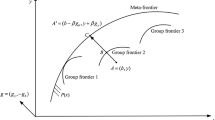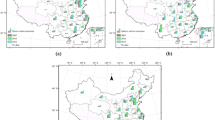Abstract
Research on construction land use efficiency with carbon emissions provides valuable insights for effective regulation of land use planning and low-carbon development. This study explores construction land use efficiency (CLUE) in China and the USA by employing a slack-based measure (SBM) that incorporates carbon emissions as undesirable output to evaluate CLUE at the provincial/state level. The abatement potential (AP) of construction land use and carbon emissions through the land utilization process are further explored. We find (1) that the average CLUE in China (0.512) is relatively higher than that in the USA, but the CLUE in both countries is at a relatively low level; (2) that carbon emissions, as undesirable output, have a negative impact on CLUE; and (3) that the average AP for construction land is 0.485 in China and 0.696 in the USA, while the average AP for carbon emissions is 0.500 in China and 0.576 in the USA. Understanding these characteristics can lead to better coordination of emissions reduction policies and land use policies to optimize the construction land inputs in both countries, thereby sustaining land use management while reducing carbon emission.





Similar content being viewed by others
Data availability
The datasets generated and/or analyzed during the current study are not publicly available due to related project policies and regulations but are available from the corresponding author on reasonable request.
References
Alig RJ, Plantinga AJ, Haim D, Todd M (2010) Area changes in US forests and other major land uses, 1982 to 2002, with projections to 2062. US Department of Agriculture, Forest Service, Pacific Northwest Research Station, Portland.
Bai X, Shi P, Liu Y (2014) Society: Realizing China’s urban dream. Nature 509:158–160
Bettinger P, Merry K (2019) Land cover transitions in the United States South: 2007–2013. Appl Geogr 105:102–110
Bigelow D, Borchers A (2012) Major uses of land in the United States 2012, US Department of Agriculture, Economic Research Service, Washington, DC
Camagni R, Gibelli MC, Rigamonti P (2002) Urban mobility and urban form: The social and environmental costs of different patterns of urban expansion. Ecol Econ 40(2):199–216
Cecchini L, Venanzi S, Pierri A, Chiorri M (2018) Environmental efficiency analysis and estimation of CO2 abatement costs in dairy cattle farms in Umbria (Italy): A SBM-DEA model with undesirable output. J Clean Prod 197:895–907
Chen J, Gao J, Chen W (2016) Urban land expansion and the transitional mechanisms in Nanjing. China Habitat Int 53:274–283
Chen W, Chen W, Ning S, Liu E-n, Zhou X, Wang Y, Zhao M (2019) Exploring the industrial land use efficiency of China’s resource-based cities. Cities 93:215–223
Chuai X, Huang X, Lu Q, Zhang M, Zhao R, Lu J (2015) Spatiotemporal changes of built-up land expansion and carbon emissions caused by the Chinese construction industry. Environ Sci Technol 49(21):13021–13030
Cooper WW, Seiford LM, Zhu J (2011) Data envelopment analysis: History, models, and interpretations. In: Cooper WW, Seiford LM, Zhu J (eds) Handbook on data envelopment analysis. Springer, US, Boston, MA, pp 1–39
Deng X, Gibson J (2018) Sustainable land use management for improving land eco-efficiency: A case study of Hebei. China Ann Oper Res 290:265–277
Deng X, Huang J, Rozelle S, Zhang J, Li Z (2015a) Impact of Urbanization on Cultivated Land Changes in China. Land Use Pol 45:1–7
Deng X, Yu Y, Liu Y (2015b) Effect of construction land expansion on energy-related carbon emissions: Empirical analysis of China and its provinces from 2001 to 2011. Energies 8(6):5516–5537
Diem JE, Ricketts CE, Dean JR (2006) Impacts of urbanization on land-atmosphere carbon exchange within a metropolitan area in the USA. Clim Res 30:201–213
Dong Y, Jin G, Deng X (2020) Dynamic interactive effects of urban land-use efficiency, industrial transformation, and carbon emissions. J Clean Prod 270:122547
Guo X, Hu A, Dai J, Chen D, Zou W, Wang Y (2018) Urban–rural disparity in the satisfaction with public sports services: Survey-based evidence in China. Soc Sci J 55(4):455–462
Han X, Zhang AL, Cai YY (2020) Spatio-econometric analysis of urban land use efficiency in China from the perspective of natural resources input and undesirable outputs: A case study of 287 cities in China. Int J Env Res Pub He 17:7297
Homer C, Dewitz J, Jin S, Xian G, Costello C, Danielson P, Gass L, Funk M, Wickham J, Stehman S, Auch R, Riitters K (2020) Conterminous United States land cover change patterns 2001–2016 from the 2016 National Land Cover Database ISPRS. J Photogramm 162:184–199
Houghton RA, House JI, Pongratz J, Van Der Werf GR, DeFries RS, Hansen MC, Quéré CL, Ramankutty N (2012) Carbon emissions from land use and land-cover change. Biogeosciences 9:5125–5142
Huang CW, McDonald RI, Seto KC (2018) The importance of land governance for biodiversity conservation in an era of global urban expansion. Landscape Urban Plan 173:44–50
Hutyra LR, Yoon B, Hepinstall-Cymerman J, Alberti M (2010) Carbon consequences of land cover change and expansion of urban lands: A case study in the Seattle metropolitan region. Landscape Urban Plan 103:83–93
Jabareen Y (2014) An assessment framework for cities coping with climate change: The case of New York City and its PlaNYC 2030. Sustainability 6:5898–5919
Kaza N (2013) The changing urban landscape of the continental United States. Landscape Urban Plan 110:74–86
Kuai P, Li W, Cheng R, Cheng G (2015) An application of system dynamics for evaluating planning alternatives to guide a green industrial transformation in a resource-based city. J Clean Prod 104:403–412
Kuang B, Lu X, Zhou M, Chen D (2020) Provincial cultivated land use efficiency in China: Empirical analysis based on the SBM-DEA model with carbon emissions considered. Technol Forecast Soc 151:119874
Liu J, Zhan J, Deng X (2005) Spatio-temporal patterns and driving forces of urban land expansion in China during the economic reform era. AMBIO J Human Environ 34:450–455
Liu S, Xiao W, Li L, Ye Y, Song X (2020) Urban land use efficiency and improvement potential in China: A stochastic frontier analysis. Land Use Pol 99:105046
Liu Y, Zhang Z, Zhou Y (2018) Efficiency of construction land allocation in China: An econometric analysis of panel data. Land Use Pol 74:261–272
Martellozzo F, Ramankutty N, Hall RJ, Price DT, Purdy B, Friedl MA (2015) Urbanization and the loss of prime farmland: A case study in the Calgary-Edmonton corridor of Alberta. Reg Environ Change 15(5):881–893
Narducci J, Quintas-Soriano C, Castro A, Som-Castellano R, Brandt JS (2019) Implications of urban growth and farmland loss for ecosystem services in the western United States. Land Use Pol 86:1–11
Nowak DJ, Greenfield EJ (2012) Tree and impervious cover in the United State. Landscape Urban Plan 107:21–30
PompermayerSesso P, Amâncio-Vieira SF, Zapparoli ID, Sesso Filho UA (2020) Structural decomposition of variations of carbon dioxide emissions for the United States, the European Union and BRIC. J Clean Prod 252:119761
Poumanyvong P, Kaneko S (2010) Does urbanization lead to less energy use and lower CO2 emissions? A Cross-Country Analysis Ecol Econ 70:434–444
Qian Z (2010) Without zoning: Urban development and land use controls in Houston. Cities 27:31–41
Sallustio L, Quatrini V, Geneletti D, Corona P, Marchetti M (2015) Assessing land take by urban development and its impact on carbon storage: Findings from two case studies in Italy. Environ Impact Asses 54:80–90
Searchinger TD, Wirsenius S, Beringer T, Dumas P (2018) Assessing the efficiency of changes in land use for mitigating climate change. Nature 564:249–253
Seto KC, Güneralp B, Hutyra LR (2012) Global forecasts of urban expansion to 2030 and direct impacts on biodiversity and carbon pools. P Natl Acad Sci USA 109(40):16083
Sleeter BM, Sohl TL, Bouchard MA, Reker RR, Soulard CE, Acevedo W, Griffith GE, Sleeter RR, Auch RF, Sayler KL, Prisley S, Zhu Z (2012) Scenarios of land use and land cover change in the conterminous United States: Utilizing the special report on emission scenarios at ecoregional scales. Global Environ Chang 22(4):896–914
Tone K (2001) A slacks-based measure of efficiency in data envelopment analysis. Eur J Oper Res 130:498–509
Tone K (2004) Dealing with undesirable outputs in DEA: A slacks-based measure (SBM) approach. The North American Productivity Workshop 2004 (NAPW III), Toronto, Canada
United Nations Framework Convention on Climate Change (2015) Adoption of the Paris Agreement (FCCC//CP/2015/L9/Rev1) https://unfcccint/resource/docs/2015/cop21/eng/l09r01.pdf [access on Oct 11th 2021]
United States Census Bureau 2010 (2010) Census regions and divisions of the United States https://wwwcensusgov/geographies/reference-maps/2010/geo/2010-census-regions-and-divisions-of-the-united-stateshtml [access on October 11th 2021]
Wang C, Zhan J, Zhang F, Liu W, Twumasi-Ankrah MJ (2021) Analysis of urban carbon balance based on land use dynamics in the Beijing-Tianjin-Hebei region. China J Clean Prod 281:125138
Wang Y, van Vliet J, Debonne N, Pu L, Verburg PH (2021) Settlement changes after peak population: Land system projections for China until 2050. Landscape Urban Plan 209:104045
Watanabe M, Tanaka K (2007) Efficiency analysis of Chinese industry: A directional distance function approach. Energy Policy 35:6323–6331
Wei C, Ni J, Du L (2012) Regional allocation of carbon dioxide abatement in China. Chin Econ Rev 23(3):552–565
Wu J (2006) Environmental amenities, urban sprawl, and community characteristics. J Environ Econ Manag 52(2):527–547
Xie X, Fang B, Xu H, He S, Li X (2021) Study on the coordinated relationship between urban land use efficiency and ecosystem health in China. Land Use Pol 102:105235
Yang B, Chen X, Wang Z, Li W, Zhang C, Yao X (2020) Analyzing land use structure efficiency with carbon emissions: A case study in the Middle Reaches of the Yangtze River. China. J Clean Prod 274:123076
Yu J, Zhou K, Yang S (2019) Land use efficiency and influencing factors of urban agglomerations in China. Land Use Policy 88:104143
Zhou C, Wang S, Wang J (2019) Examining the influences of urbanization on carbon dioxide emissions in the Yangtze River Delta, China: Kuznets curve relationship. Sci Total Environ 675:472–482
Zhu X, Li Y, Zhang P, Wei Y, Zheng X, Xie L (2019) Temporal–spatial characteristics of urban land use efficiency of China’s 35mega cities based on DEA: Decomposing technology and scale efficiency. Land Use Policy 88:104083
Funding
This study was supported by the National Natural Science Foundation of China (Grant No. 72004209).
Author information
Authors and Affiliations
Contributions
Ying Wang contributed to methodology and writing—original draft. Ji Chai performed reviewing and editing. Hongwei Zhang performed reviewing and supervision. Bin Yang done investigation and validation.
Corresponding author
Ethics declarations
Ethics approval
Not applicable.
Consent to participate
Not applicable.
Consent to publication
Not applicable.
Competing interests
The authors declare no competing interests.
Additional information
Responsible Editor: Philippe Garrigues
Publisher's note
Springer Nature remains neutral with regard to jurisdictional claims in published maps and institutional affiliations.
Rights and permissions
About this article
Cite this article
Wang, Y., Chai, J., Zhang, H. et al. Evaluating construction land use efficiency under carbon emission constraints: A comparative study of China and the USA. Environ Sci Pollut Res 29, 49998–50009 (2022). https://doi.org/10.1007/s11356-022-19475-6
Received:
Accepted:
Published:
Issue Date:
DOI: https://doi.org/10.1007/s11356-022-19475-6




